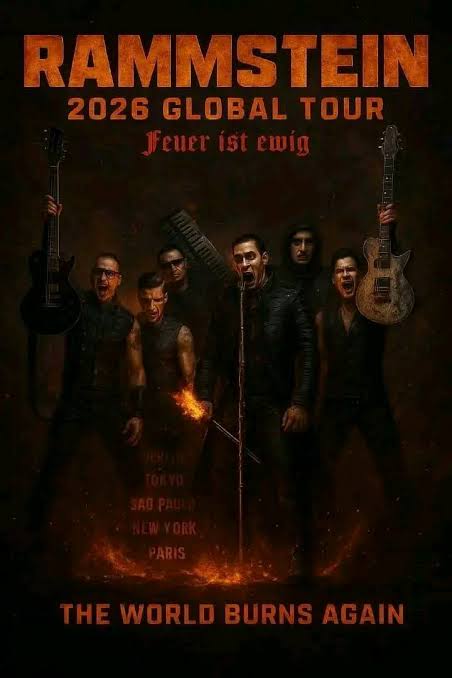FROM FIRE TO FURY: RAMMSTEIN’S EVOLUTION FROM RAW 90s REBELS TO UNSTOPPABLE MODERN TITANS — THE LEGACY OF GERMANY’S MOST DANGEROUS BAND 🔥🎸🇩🇪
When Rammstein first exploded onto the scene in the mid-1990s, the world wasn’t ready. Out of the smoky, industrial shadows of post–Cold War Germany emerged six men armed with brutal riffs, mechanical precision, and a theatrical darkness that redefined what heavy music could be. Songs like “Du Hast” and “Engel” didn’t just make noise — they ignited a cultural revolution, birthing a new genre, Neue Deutsche Härte (New German Hardness), that fused metal, industrial, and electronic fury into something wholly unique.
Today, nearly three decades later, Rammstein still stands tall — older, wiser, and more dangerous than ever. Their evolution from gritty, underground firestarters to one of the biggest live acts in the world is nothing short of legendary. But what makes Rammstein’s story so compelling is that, unlike many of their peers, they have never lost their edge. Instead, they’ve transformed it — refining chaos into art, aggression into philosophy, and shock into storytelling.
🔥 THE RAW BIRTH OF RAMMSTEIN — 1994 TO 2001
In their early years, Rammstein embodied rebellion. Their debut album, Herzeleid (1995), was a sonic declaration of war — cold, relentless, and pulsating with industrial grit. The band’s sound combined Richard Kruspe’s machine-gun guitar riffs, Christoph Schneider’s militaristic drumming, and Till Lindemann’s deep, menacing voice, delivering something primal yet meticulously structured.
When Sehnsucht dropped in 1997, Rammstein went global. “Du Hast” became an anthem — its hypnotic rhythm and cryptic lyrics making it an instant classic. The accompanying videos and live shows introduced the world to Rammstein’s signature blend of pyrotechnics, sexuality, and controversy. Their concerts weren’t just performances — they were rituals of fire and defiance.
By the early 2000s, Rammstein had solidified their place as the face of modern German metal. Their music videos — often banned, always talked about — became statements against censorship, hypocrisy, and political apathy.
⚙️ THE REINVENTION ERA — 2004 TO 2015
The release of Reise, Reise (2004) marked a turning point. Rammstein began to evolve — musically, visually, and lyrically. The sound became broader and more cinematic, incorporating orchestral arrangements, acoustic guitars, and haunting melodies. Songs like “Amerika” and “Ohne Dich” revealed a new emotional depth beneath the industrial armor.
The band’s follow-up, Rosenrot (2005), continued this trend — a reflection of maturity and introspection. But it was 2009’s Liebe Ist Für Alle Da that reminded fans that Rammstein could still bite. With tracks like “Pussy” and “Ich Tu Dir Weh,” they once again pushed every boundary imaginable — a bold refusal to conform even after global success.
Their live shows evolved into cinematic experiences — blending fire, satire, and social commentary. Each concert became a mirror to society’s contradictions, performed with mechanical precision and primal energy.
🔥 NEW RAMMSTEIN: WISDOM, POWER, AND CONTROL — 2019 TO NOW
Fast forward to the modern era — Rammstein, older but not gentler. Their self-titled 2019 album proved that time had not dulled their edge; it had sharpened it. Tracks like “Deutschland” and “Radio” explored history, identity, and the dark complexity of German culture. The band took on nationalism, technology, and morality with the same unflinching honesty that made them infamous.
The follow-up, Zeit (2022), added another layer — reflection. It was less about rage and more about mortality, nostalgia, and the passage of time. Yet, even in restraint, Rammstein’s power burned brighter than ever. The production was razor-sharp, the lyrics deeper, and the performance — monumental.
As they prepare new material rumored for 2026, insiders describe the sound as a mix of Herzeleid-era rawness and Zeit’s introspective poetry — a perfect storm of aggression and wisdom.
💀 THE LEGACY — STILL DANGEROUS, STILL ALIVE
Rammstein’s evolution isn’t about softening with age; it’s about mastering the chaos. In the 1990s, they were the hammer — loud, relentless, destructive. In the 2020s, they’ve become the fire — controlled, intelligent, and consuming everything it touches.
Till Lindemann, now in his 60s, remains one of rock’s most magnetic and controversial figures. His voice — a deep, poetic growl — carries both violence and vulnerability. His lyrics, often wrapped in metaphor, explore the dark corners of humanity without apology.
What keeps Rammstein alive is authenticity. They never followed trends, never watered down their sound, and never apologized for who they are. Their art remains both political and personal — a reflection of a world still full of division, beauty, and rage.
🔥 WATCH NOW — A LEGEND REBORN
In 2025, as rumors swirl of a new album and tour, one thing is certain: Rammstein is not done. Their fire hasn’t faded — it’s evolved. What began as a spark of rebellion in 1994 has become a blazing inferno that continues to burn across generations.
From the raw aggression of “Du Hast” to the haunting beauty of “Zeit,” Rammstein has proven that real power doesn’t fade — it transforms.
So, as the world watches and waits, one truth stands tall: Old or new, Rammstein remains unstoppable — the eternal heartbeat of German industrial metal. ⚡🔥🎤
